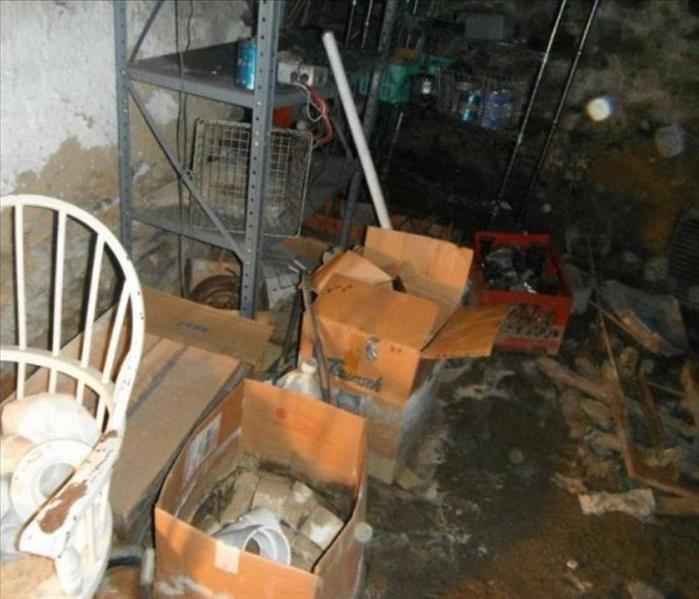Recent Water Damage Posts
Water restoration done the right way
10/20/2022 (Permalink)
 Water damage restoration, the SERVPRO way!
Water damage restoration, the SERVPRO way!
When disaster strikes it is important to act fast to avoid secondary damage, like mold. It is also very important to find the right restoration provider that will do the job the correct way the first time.
When choosing a provider, find a provider that is IICRC certified. The IICRC is the organization that oversees the restoration industry standards. When dealing with residential water damage, the pertaining certification is WRT.
Our team is certified and experienced to assist with all categories and classes of water damage. If you experience any type of water damage, call our office, we can walk you through what needs to happen and take care of it right away. Always remember that our team is always here to help and make it "Like it never even happened!"
Frequently asked question- Does water damage dissipate on it's own?
9/30/2022 (Permalink)
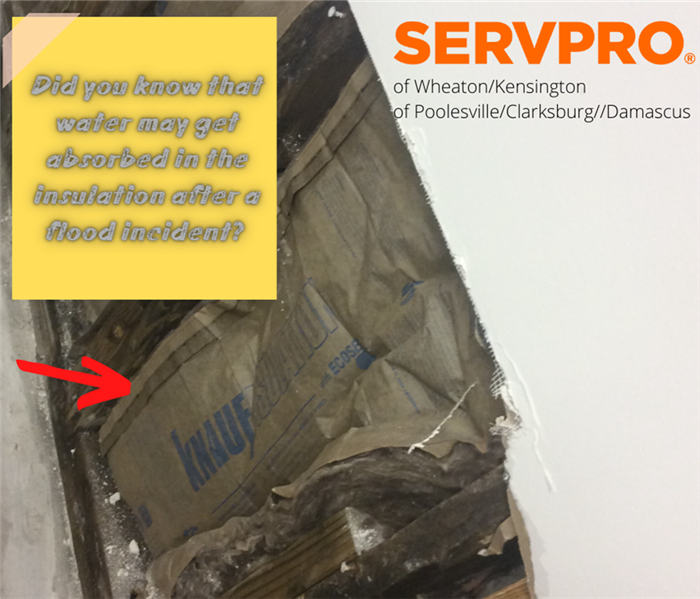 Don't wait, call us right away!
Don't wait, call us right away!
When water damage occurs in a home or business we frequently ask ourselves, will the water dissipate on its own? The short answer to this question is no. Water travels to a place it can be absorbed and can cause subsequent secondary damages to your home such as microbial growth, also known as mold. To avoid secondary damages you must mitigate the initial water damage properly and in a timely manner. You may ask yourself- Where does water travel? Well, water can be absorbed by the insulation behind a wall or any other nearby porous materials or textures. Finding the right professionals to assist can save you time and more damage to your personal belongings and home. Our team will help you put together a game plan that fits your situation. In many scenarios, our team must remove drywall and insulation due to it not being salvageable and preventing secondary damage. If you are experiencing water damage give us a call, we are always here to help and make it “Like it never even happened.”
What is the life expectancy of a tank water heater?
8/10/2022 (Permalink)
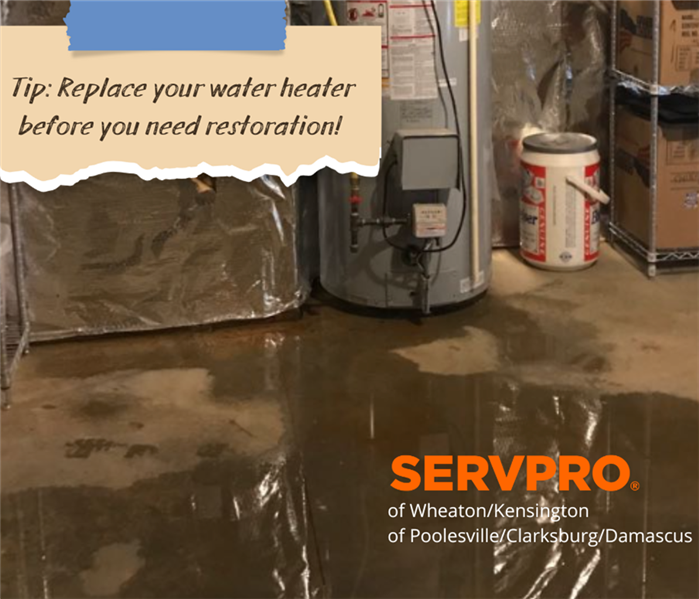 Did you know that the life span of a tank water heater is between 8-10 years?
Did you know that the life span of a tank water heater is between 8-10 years?
Replacing appliances can be either daunting or gratifying, or both. When the need to replace a major appliance, like a tank water heater, arises it’s best to take care of it prior to them malfunctioning or failing. The typical life span of a tank water heater is between 8-10 years, however, it may be recommended to replace it prior to then. One thing is for sure, you do not want to replace a tank water heater unexpectedly. Residential tank water heaters can hold between 30-80 gallons of water, depending on how many people live in the residence. Can you imagine the catastrophe that amount of water can cause in your home should your water heater go out?
If you are experiencing water damage due to water heater failure or malfunction, feel free to contact our experienced team. Our staff will walk you through the water restoration process and make appropriate recommendations. Remember that your local SERVPRO of Poolesville/Clarksburg/Damascus is always here to help and make it “Like it never even happened!”
A prompt response to water damage is key!
4/26/2022 (Permalink)
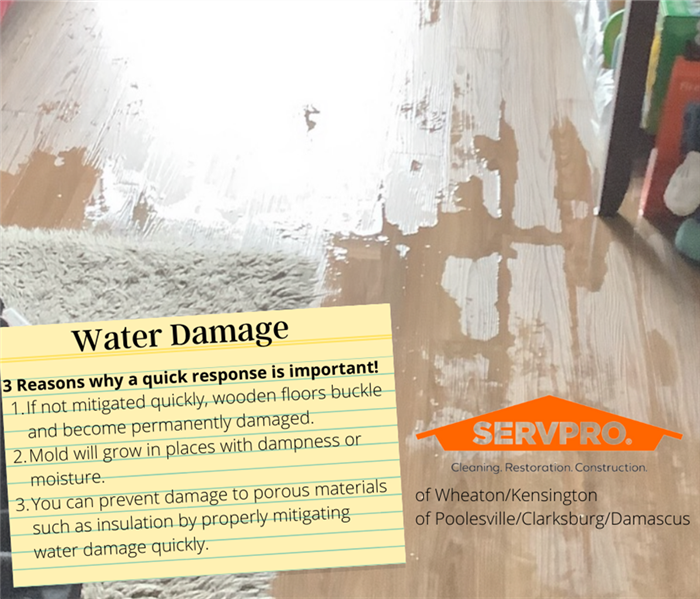 Prompt response to a water disaster is key!
Prompt response to a water disaster is key!
When a water disaster strikes the emotions can be overwhelming but you must always remember that your prompt response will be very detrimental. Here are three reasons why beginning the water mitigation process will make all the difference in how promptly your home or business will return to its pre-water damage condition.
3 Reasons why a quick response is important
- If not mitigated quickly, wooden floors buckle and become permanently damaged.
- Mold will grow in places with dampness or moisture.
- You can prevent damage to porous materials such as insulation by properly mitigating water damage quickly.
We are happy to explain the water mitigation process for a better understanding of what it will take to properly mitigate your home. Every water loss is different and unique in its own ways, our approach is a customized one to fit your specific needs. Feel free to reach out for a free water loss assessment if needed. We are always here to help and make it “Like it never even happened.”
Warning. Snow is in the forecast ahead!
1/19/2022 (Permalink)
 Have our contact information handy, just in case.
Have our contact information handy, just in case.
Our area is expecting snow within the next 24 hours. Along with the snow, we are expecting low temperatures also. Low temperatures are typically the cause of broken pipes due to them freezing. If you see that a pipe is frozen in your home, attempt to defrost it with a space heater or blowdryer, this may help prevent a broken pipe. We recommend that you know the main shut-off valve is, just in case. It is also a good idea to run water in your faucets, this helps by thawing the water in your faucets and freely draining and relieving the pressure in your pipes.
If you are in need of a water restoration provider, please give us a call. Our team specializes in restoring homes and businesses after there has been water damage. We can dry out the structure properly to prevent mold from forming due to moisture left behind. Always remember that your local SERVPRO of Poolesville/Clarksburg/Damascus is here to help, and make it “Like it never even happened.”
What kind of water damage are you experiencing?
5/17/2021 (Permalink)
 Water contamination categories
Water contamination categories
Water damage can happen to anybody. In fact, according to research done by the insurance industry, it is estimated that 37% of homeowners claim to have suffered damages due to a flood. Did you know that insurance companies pay out $2.5 billion dollars per year in water and mold losses? As you can see, water damage can happen to anybody and it can be costly to mitigate. With that, knowing what type of water damage you are experiencing may help you know how to react or know what you are truly facing. Here is the list of the different categories of water contamination.
Category 1
Water that originates from a sanitary source and is considered fit for human consumption. (Water from the sink faucet, Clean toilet water)
Category 2
Water from a contaminated source can potentially cause harm if consumed. (Dishwasher water)
Category 3
Water that is “grossly contaminated” and contains harmful toxins or pathogens. (Sewage backup, standing water, stormwater)
The best way to know how to react is by knowing what you are dealing with. We hope that you found this information helpful. Always remember that your SERVPRO of Poolesville/Clarksburg/Damascus is always here to help and make it "Like it never even happened."
The water restoration process, the SERVPRO way!
11/2/2020 (Permalink)
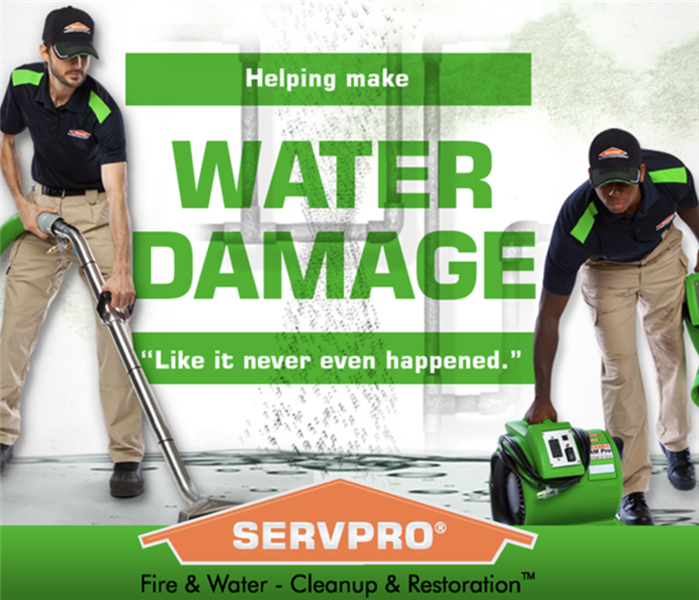 SERVPRO, Water Restoration Professionals
SERVPRO, Water Restoration Professionals
We would like to explain the restoration process for those who haven’t experienced a water loss. We hope this gives you insight and a better idea on how to handle the situation should you need assistance.
Initial call: When you call our office with a water loss we focus on gathering as much information as possible, this will help us prepare before we arrive.
Assessment process: At this point we analyze the loss and determine what the best approach will be. This includes determining the category of water.
Water removal: We continue with removing excess water with our water extraction equipment. We also remove any porous material that can not be salvaged.
The drying process: Once excess water had been removed, we start the drying process. We strategically set our dehumidifiers and air movers in the affected area, according to the IICRC standards.
Cleaning and sanitizing: When the affected area is dry we remove our equipment and proceed with cleaning and sanitizing the affected areas. We apply antimicrobial products where necessary.
Reconstruction: In some water loss cases we have to remove drywall, carpet, hardwoods, or other materials. Once we have completed the water mitigation, we put it all back what ever we removed.
If you would like more information regarding our water restoration process, give us a call at (301)332-0766. We hope this information was helpful. Always remember that your local SERVPRO is here to help and make it “Like it never even happened.”
Categories of Water Contamination
1/7/2019 (Permalink)
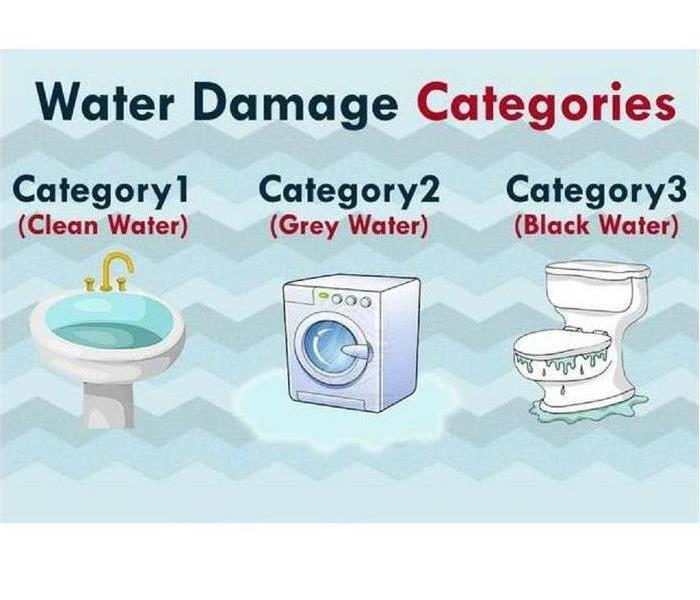 All water losses are different!
All water losses are different!
Here at SERVPRO of Poolesville/Clarksburg/Damascus safety is our first priority. Knowing how to react when you experience a water loss is vital to you and your families’ health. All water poses potential health problems. It is the single leading cause of disease in the world. Understanding the different types of water contamination levels and their health risks can make a big difference in restoration process as well as minimize your chances in becoming sick. This information will help you determine if you need to evacuate the home or not. Below you will find a description of the different types of water contamination categories.
Category 1 – Clean Water: This water originates from a sanitary water source that does not pose substantial harm to humans. This may include broken water lines, tub or sink overflows with no contaminants, appliance malfunctions involving water supply lines, melting ice or snow, falling rain water, broken toilet tanks and toilet bowls that do not contain contaminants or additives.
Category 2 – Gray Water: This water contains a significant level of contamination and has the potential to cause discomfort or sickness if consumed by or exposed to humans. Examples of this include discharge from dish washers or washing machine overflows, toilet overflows, toilet overflow with urine, but not feces, and other sources where water has been contaminated.
Category 3 – Black Water: This water is grossly contaminated and may contain pathogenic, toxigenic or other harmful agents. Elderly, children under the age of 2, and people with respiratory issues should not occupy the facility until the building safe. Examples of Category 3 water are all forms of flooding due to sewage, flooding due to sea water or rain fall (rain, natural disaster), and colored water,
Keep in mind that every water loss is different, and determining the type of water category you have is the first step towards figuring out what the next step is. Once we establish the water category we put together our plan of action.
The information above was provided by The Institute of Inspection Cleaning and Restoration Certification (IICRC). We hope we’ve provided a better insight on the different water types. Remember that your SERVPRO of Poolesville/Clarksburg/Damascus is always here to help, and make it “Like it never even happened.”
Faster to your Poolesville/Clarksburg/Damascus water loss!
6/8/2018 (Permalink)
 Let the professionals handle it!
Let the professionals handle it!
Along with a water loss comes a flood of emotions. You may be confused as to what to do next, or who to call. Here are a few tips on what your next steps should be, and whose information you should have handy just in case you have this unfortunate event happen to you.
First steps to follow for a water loss for clean water.
- Shut off the source of water if possible.
- Turn off circuit breakers for wet areas of the building, when access to the power distribution is safe from electrical shock.
- Remove excess water by mopping and blotting.
- Remove and prop up wet upholstery cushions for even drying.
- Place aluminum foil or wood blocks under furniture legs.
- Hang furs and leather goods separately at room temperature.
- Do not use a regular vacuum to remove water.
- Remove oriental or other colored rugs/books/magazines from wet carpeting.
Whose information should you have handy?
- We recommend you have an Emergency Ready Plan in place with your local SERVPRO location. This will facilitate the process for both you and your local SERVPRO. In the ERP form we have most of the essential information needed to begin the mitigation process for your home or business.
- Your Insurance Adjuster should be notified immediately after or during your loss.
- Your Plumber should be notified if the loss occurred due to plumbing/pipe issues. If the loss occurred due to those issues they can repair the cause of the of the water loss. Remember that when a water loss occurs you are in a sensitive time frame to be able to recuperate your personal property and prevent further damage such as mold etc...
Have this important information ready just in case. Also keep in mind that our goal is to make it "Like it never even happened."
Your SERVPRO of Poolesville/Clarksburg/Damascus is always here to help!
Bathtub and Dishwasher Overflow
10/30/2017 (Permalink)
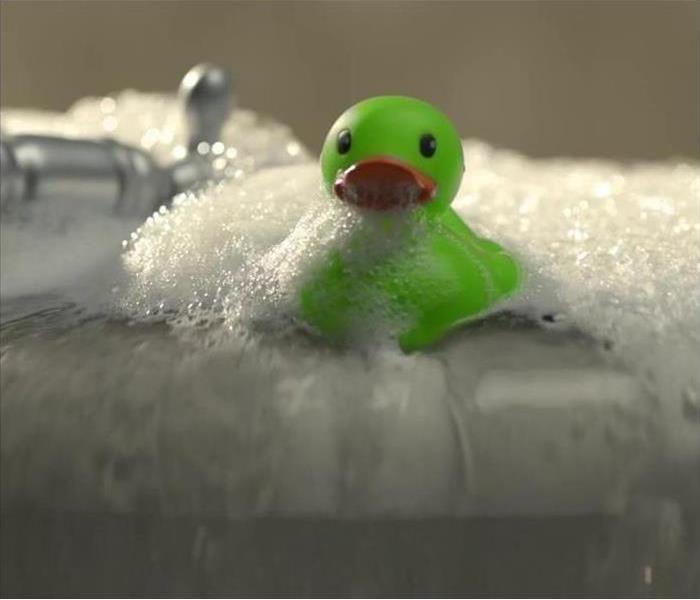 bathtub
bathtub
Bathtub overflow: It’s important to make sure that fittings, seals, pipes, etc. are inspected thoroughly to prevent issues such as water damage.
The bathtub overflow drain can be the cause of a leak, even though it is not the first place you'd usually suspect. A water stain in the ceiling below a bathroom is often the first sign of a problem with a tub overflow drain.
Dishwasher Overflow: Is this something you've experienced before? "Why is my dishwasher leaking, where is it coming from?" There are many questionable factors for why a dishwasher is leaking
In these cases, make sure to contact a licensed and trained professional, like SERVPRO, to fix the issue. Our technicians source out the problem and fix the surrounding areas affected by water damage. It's not a fun experience dealing with any type of unexpected home repair, or disaster. However, SERVPRO helps alleviate your stress and turn your home back to a comfortable and functional space. While catching the problem early, it saves time and money.
Flooded Basement in Kensington
2/16/2016 (Permalink)
A water main break caused a basement to flood in Kensington, MD. This picture shows the mess left behind after all water had receded.
SERVPRO of Kensington/Wheaton was called in to clean up the aftermath! The owner was thrilled and said "This basement has never looking this good in the 24 years we have owned this property."



 24/7 Emergency Service
24/7 Emergency Service










